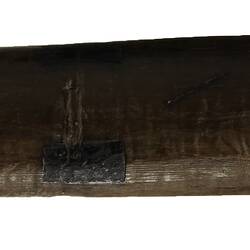Summary
This hardwood kallak (club) features a distinctive design that has been incised into its body. It is the same as the design on an associated club, indicating the two were made by the same man, providing an important historical record of a craftsman's use of design to identify his work and weapons.
'We use technology relating to wood burning for our designs, very precise images are achieved. Originally, we used irons in the fire years ago, where you would have to bend and shape wire in the fire to do markings. The new process, using small machines, speeds things up. It was a different technology in the old days, which required different skills and knowledge of the concentration of heat and smoke. We don't disturb the trees but only take a small part of them to make our artefacts. The woods we select in our area are blackwood, wattle, hickory (acacia family), ironbark, red box, banksia and sheoak.' Uncle Albert Mullett, Gunai/Kurnai Elder and master carver, 2012.
Local Name
Kallak
Physical Description
Sword shaped club of hardwood. Blade like shaft decorated with burnt rectangular patterns over the surface. Handgrip consists of 12 grooved bands. Handle consists of a conical shaped knob; the surface has been roughened with incised lines.
Significance
Historical records indicate this club was among the large amounts of material culture taken overseas from Victoria at some point in the 19th and 20th centuries. It came into the Museum Victoria collection in 1995 through a donation by an international collector.
As with many items collected in colonial times, widespread ignorance of the distinctiveness of Aboriginal Nations and peoples throughout Australia meant that it was rare for makers and Nations to be named or correctly attributed. Further complicating issues of provenance, Aboriginal peoples were also forcibly removed from their lands and placed in areas (such as missions) far from and not associated with their own Nation or culture.
Historian Tom Griffiths beautifully explains the ignorance of early collectors by asserting that 'armchair theorists were only too ready to disregard the original context of these chunks of culture...collection was often an act of distancing.' (From Tom Griffiths, 1996 'Hunters and Collectors; the Antiquarian Imagination in Australia' pg 54.)
The Gunai/Kurnai people continue to make cultural items from wood with skills and knowledge passed down over thousands of generations.
More Information
-
Object/Medium
Club
-
Maker
-
Locality
-
Date Produced
-
Collector
-
Object Measurements
830 mm (Length), 70 mm (Width), 45 mm (Height)
-
Classification
-
Date Made
-
Maker
-
Clan/Language Group
-
Place Made
-
Indigenous Region
-
Keywords
-
Collection Names
-
Type of item
-
Discipline
-
Category
-
Collecting Areas



